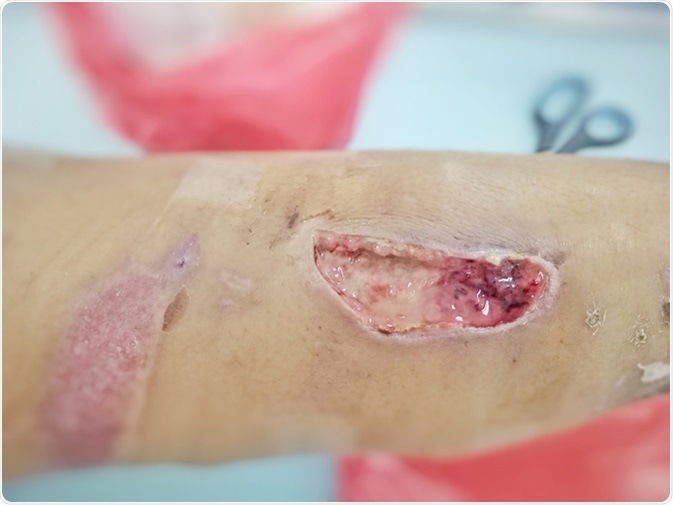Hard-to-heal wounds can come about in many ways. For example, around 50 percent of the elderly population in Italy have an experience with a hard-to-heal wound at some point in their later years – meaning that this is a major concern for the elderly community.
Also, people suffering from Diabetes Mellitus (type I or II) can have trouble in wound healing, especially in extremities such as their legs and feet. Hard-to-heal wounds can take many forms, from pressure ulcers (bedsores) to cuts or surgical wounds.
Hard-To-Heal Wound Formation
Pressure Ulcers
An example of a hard-to-heal wound is a pressure ulcer, otherwise known as bedsore. These form on bony prominences, usually in cases where people are immobilized for extended periods of time such as people who are injured or the elderly.
A pressure ulcer starts off as an area of skin which has been under physical pressure for a long time, which can decrease blood flow. The skin can begin to break, with the subcutaneous layer becoming exposed – as well as muscle and tendon exposure occurring in more severe cases. These are classified as hard-to-heal wounds, as because the patient cannot move, the pressure on the wounded area can rarely be fully alleviated.
Furthermore, pressure ulcers are usually not discovered by healthcare professionals until they have progressed to a severe stage as they are usually underneath the patient’s body, so are therefore difficult to spot.

Diabetes Wounds
Another example of a head-to-head wound is that of a person who has the condition Diabetes Mellitus – wither type I or type II. If a patient with diabetes develops a foot ulcer (a break in the skin caused by excessive pressure and/or rubbing of a small region of the sole of the foot), it can worsen very rapidly.
This can occur because of a variety of underlying conditions – with one of the main causes being venous insufficiency, which is where the veins within the peripheral parts of the body (e.g. feet and legs) are not functioning properly.
With these underlying conditions, the ulcer cannot become fully healed, as there is not enough blood flow to the skin surrounding the wound, leaving those areas deficient in platelets and other healing blood constituents.
This same problem can arise if a person with Diabetes Mellitus type I or II undergoes surgery on any peripheral parts of the body, as the surgical wound cannot fully heal. This usually leads to infections, sepsis, or Necrotising fasciitis.
Hard-To-Heal Wound Treatment
Wound Care
Usually, hard-to-heal wounds are treated using basic washing and dressing, with the dressing being changed regularly. However, if an improvement isn’t seen, other measures must be taken to help the wound heal fully.
Skin Graft
Skin grafts from other parts of the body are required to help seal wounds which are not closing fully, such as large ulcers.
Platelet-Derived Growth Factors
For diabetic foot ulcers, a new treatment is being tested involving platelet-derived growth factors and an ester of hyaluronan – both of which are involved in the natural healing of wounds. In a study performed in 2000, encouraging results were obtained when a granulocyte-colony stimulating factor was applied to a diabetic ulcer, which encouraged natural wound healing without adequate peripheral venous function.
Amputation
Unfortunately, in many cases of hard-to-heal wounds, especially in patients who suffer from type I or II diabetes, the final solution is to amputate the wounded limb/area up to a point where the venous function is advanced enough to fully heal the new surgical wound naturally.
In older patients suffering from pressure ulcers/bedsores, if these wounds can not heal fully with current treatment methods, the patient usually passes away due to other underlying issues. These wounds can also become infected, which can cause sepsis that takes hold very rapidly, as they are too old to fight the infection on their own.
Sources
- The use of an antioxidant dressing on hard-to-heal wounds: a multicentre, prospective case series
- Wounds Difficult to Heal: An Effective Treatment Strategy.
- A bilayered living skin construct (APLIGRAF®) accelerates complete closure of hard‐to‐heal venous ulcers
- International Guideline: Pressure Ulcer Treatment Technical Report
- Comparison of healing of surgical wounds between diabetics and non-diabetics.
- New treatments in ulcer healing and wound infection
Further Reading
- All Wound Healing Content
- Hydrogel Dressings
- Bioactive Glass Implants and Wound Care
- Diabetes and Wound Healing
- Preventing Infection in Open Wounds
Last Updated: Oct 15, 2018
Written by
Phoebe Hinton-Sheley
Phoebe Hinton-Sheley has a B.Sc. (Class I Hons) in Microbiology from the University of Wolverhampton. Due to her background and interests, Phoebe mostly writes for the Life Sciences side of News-Medical, focussing on Microbiology and related techniques and diseases. However, she also enjoys writing about topics along the lines of Genetics, Molecular Biology, and Biochemistry.
Source: Read Full Article
